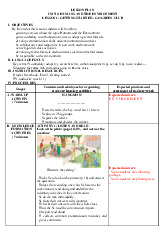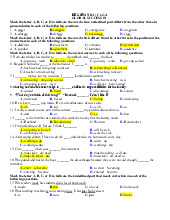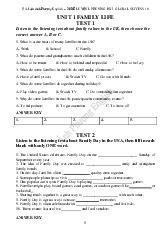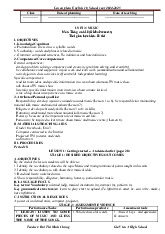



Preview text:
P 50: LESSON 4: Listening and Writing
STAGE 1: DESIRED OBJECTIVES/ OUTCOMES A. OBJECTIVES
By the end of the lesson, students will be able to:
1. Listen and choose the best options to complete the paragraph
2. Listen and choose the best option to answer the questions. B. LANGUAGE FOCUS
Key terms/ Vocabulary: smart phone, device, donate, volunteer,….
Key grammatical structure(s): Past Simple vs Past Continuous with when and while, Present
Perfect, Gerunds and To Infinitives .
C. INSTRUCTIONAL RESOURCES Computer, projector,…
STAGE 2: ASSESSMENT EVIDENCE Performance Tasks Performance products Assessment tools 1.Answer keys and
1.Warm up: Game - HANGMAN
1.Individual’s answer
questions & answers
2. Listen to the passage and
1. Individual’s written answers 1. Answer keys and
complete the passage by choosing
(passage with topics community questions & answers
the correct words/ phrases. and inventions )
3. Listen to the passage and answer 2. Pairs’ written answer 2. Answer keys
the questions by choosing the correct (choosing correct options) Questions & answers options. Peer correction
4. Rearrange the sentences to make 4. Individual’s written answer (a 4. Answer keys meaningful paragraph. short paragraph about Observation community or inventions. ) Questions & answers Peer correction
STAGE 3: TEACHING PROCEDURE/ LEARNING EXPERIENCES Notes:
In each activity, each step will be represented as following: * Deliver the task ** Implement the task *** Discuss
**** Give comments or feedback
TASK 1: WARM UP : GAME: HANGMAN
* T writes 9 blank letters on the board. _ _ _ _ _ _ _ _ _
** Ss guess the letters in turn.
*** The class plays the game together. The first student to get the correct answer is the winner.
**** T checks if the answers are correct or incorrect and leads in the lesson. Key : COMPUTER
Task 2: LISTEN AND CHOOSE THE BEST OPTION FOR EACH BLANK.
* T explains the activity. T asks Ss if they know how a computer useful is.
** Ss read the incomplete passage, listen and choose the best one to complete the passage as they listen.
- Before having Ss do the task, T reviews the techniques for this type of exercise, e.g. skimming
through the note, predicting parts of speech and answers based on context clues.
- T gives Ss some time to skim through the note and try to work out the answers before they listen. ** Ss do as instructions.
*** Ss work individually and then compare their answers with their friends.
**** T gives feedback and discusses with the class.
Key: 1. A. helpful 2. B. information 3. C. a lot of 4. C. almost Tapescripts:
Listen and mark the letter A, B, C, or D to indicate the correct word or phrase that best fits each of the numbered blanks.
Computers are …………. (1) in many ways. First, they are fast. They can work with (2)
………………. . even more quickly than a person. Second, computers can work with (3) ………
information at the same time. Third, they can keep information for a long time. They do not get thing
the common people do. Also, computers are (4) ……………. always correct. They are not perfect, of
course but they usually do not make mistakes. 1. A. helpful B. grateful C. careful D. beautiful 2. A. formation B. information C. communication D. education 3. A. a lot B. lot of C. a lot of D. many of 4. A. most B. mostly C. almost D. most of
TASK 3: LISTEN AND CHOOSE THE BEST ANSWER FOR EACH QUESTION.
* T explains the activity.
- T asks Ss to listen to the passage/ conversation. This time they are choosing the best answer for each question.
*** Ss work individually and then compare their answer with the friend’s.
**** T gives feedback and discusses with the class. Key: 1.D. 2. .B 3..A 4. A
Listen and answer the questions
Mr. Brown and some volunteers are on a very dirty beach now. Today they are ready to make the
beach a clean and beautiful place again. After listening to Mr. Brown's instructions, they are divided
into three groups. Group 1 needs to walk along the beach. Group 2 should check the sand, and group 3
has to check among the rocks. Garbage must be put into plastic bags, and the bags will be collected by
Mr. Brown. He will take the bags to the to garbage dump. 1. Where is Mrs Brown now? A. at home B. at school C. on a clean beach D. on a very dirty beach 2. How many groups are there? A. 2 B. 3 C. 4 D.5
3. Which group should check the check the sand? A. Group 2 B. group 3 C. group 4 D. group 5 4. Who will collect the bags A. Mrs Brown B. students C. local people D.students in group 4
TASK 4: WORK IN GROUPS. WHAT IS THE CORRECT ARRANGEMENT OF THE PASSAGE. Step 1: Brainstorm
* T asks Ss to work in groups and brainstorm ideas to answer the question: What should we do to help improve the environment?
** T asks Ss to share their ideas and write them on the board. Ss can use the ideas in students’ book page 65.
*** Ss contribute to the discussion and note down the important points in their notebooks.
**** T checks the answers and gives feedback. Suggested ideas: - three/ four things
- Firstly/ The first/ First
- Secondly/ The second/ Second - Thirdly/ The third/ Third
- Finally/ Lastly/ The last/ Last
- In conclusion/ In brief/ To sum up/ All in all....
Step 2: Rearrange the sentences to make the passage.
* T explains the task: Ss must finish a paragraph about what we should do to improve the
environment. ** Ss rearrange the sentences.
*** T gives Ss enough time to rearrange and write their parragraph. T walks round the class and offers help.
**** T collects some or all Ss’ writings to give written feedback. Sample answer:
Mark the letter A, B, C, or D on your answer sheet to indicate the correct arrangement of the
sentences to make a meaningful paragraph/ letter in each of the following questions. Question 16.
a. Firstly, we should clean up all areas regularly. For example, we can organise clean-up activities at weekends.
b. There are three things we can do to improve the environment in our school.
c. Secondly, we ought to set up more rubbish bins. For instance, we can put more rubbish bins in the
school gate, in front of each building, or in the playground.
d. In conclusion, we can improve the environment in our school in many ways and even small actions can make a big difference.
e. Finally , we should plant more trees. To give an example, we can encourage students to plant trees or
flowers in our school because this reduces CO2 and makes the air clean. 1. b 2. a 3. c 4. e 5. d WRAP-UP
T talks about what they have learnt in the lesson.
- Practice listening for general and specific information about smart homes;
- Practice talking about a other features a smart home should have . HOMEWORK
- Prepare for Review for the first term test – Skills (Reading and Writing).
P 51: LESSON 5: Skills (Reading )
STAGE 1: DESIRED OBJECTIVES/ OUTCOMES A. OBJECTIVES
By the end of the lesson, students will be able to:
1. Review the use of relative pronouns, expression of quantity/ to-V, V-ing..
2. Choose the best option to complete the paragraph. (close test)
3. Show responsibility in helping the community B. LANGUAGE FOCUS
Key terms/ Vocabulary: voluntary, for a better community, inventions,…
Key grammatical structure(s):
C. INSTRUCTIONAL RESOURCES computer, projector.
STAGE 2: ASSESSMENT EVIDENCE Performance Tasks Performance products Assessment tools
1.Individual’s oral answer ( a 1.Answer keys
1.Warm up : Guessing the word speech) Questions & answers Peer correction
2. Do some ex about relative
2.Individual’s oral answer ( a 2. Observation
pronouns, expression of quantity speech) Questions & answers
and to-V, V-ing, connectors
3. Read the text again and choose
3. Individual’s oral answers ( a 3. Answer keys
the best answer. (close test) speech) Questions & answers Peer correction
4. Read the text again and choose 3. Individual’s oral answers ( a 4. Answer keys the best answer.( reading speech) Observation comprehension) Questions & answers Peer correction
STAGE 3: TEACHING PROCEDURE/ LEARNING EXPERIENCES



